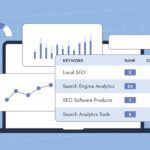
Are you wondering if headless Shopify is better for SEO? You’re not the only one asking. Many online store owners are curious about this modern approach to e-commerce and its impact on search rankings.
As a digital marketing and SEO agency we make sure we stay on top of web development trends to keep our clients up to date on everything.
In this article, we’ll break down the advantages and disadvantages of using a headless Shopify setup for your SEO efforts. We will examine how this architecture can affect your search engine rankings and overall visibility online.
What is Headless Shopify?
Before exploring the SEO implications, let’s first understand headless Shopify. With a traditional Shopify setup, the platform manages both the backend content and the frontend presentation layer. A headless Shopify architecture separates these two components.
Shopify continues to power the backend, handling products, orders, and customer data. However, the frontend, or the “head,” is detached, allowing you to build a custom storefront using any technology you prefer. This API-first architecture uses application programming interfaces (APIs) to connect the backend with the custom-built frontend.
This separation gives you immense creative freedom over your online store’s design and functionality. It is like having a completely custom website with Shopify’s robust commerce engine working quietly behind the scenes. This setup is popular among online businesses and large websites looking for flexibility beyond what a traditional CMS offers.
How Headless Shopify Affects SEO
Now, let’s get to the core question about SEO. Can a headless Shopify store provide an advantage in search rankings? The answer has multiple layers, with significant benefits and potential difficulties to consider for your SEO strategy.
Advantages for SEO
Going headless can offer several compelling advantages for your SEO optimization. These benefits often stem from enhanced performance and greater control over technical elements. Many businesses see a significant lift in their organic search performance after making the switch.
Superior Site Speed and Performance
Site speed is a critical factor for search engines and a cornerstone of a good user experience. A headless commerce setup can result in dramatically faster load times. This improved performance is because frontend developers can use modern, lightweight frameworks like Next.js or Gatsby.
These technologies can pre-render pages as static files, which load almost instantly in a user’s browser. Faster site speed directly impacts Google’s Core Web Vitals, which are important for search rankings. Reducing load time keeps users happy and can lead to higher conversions.
Enhanced User Experience & Engagement
With a headless Shopify store, you have complete freedom over the site’s design and user journey. This allows for the creation of a smooth and highly engaging customer experience that is impossible with template-based systems. You can personalize content, create unique interactive elements, and guide users seamlessly from discovery to checkout.
Google rewards sites that provide a good user experience with higher rankings. Increased user engagement signals, such as lower bounce rates and longer time on page, tell search engines that your content is valuable. This can directly boost your position in search results.
Unmatched Control Over Technical SEO
A headless Shopify setup provides granular control over all aspects of technical SEO. A traditional Shopify store has some limitations, especially concerning URL structures. Shopify’s native URL format can be rigid and not always ideal for SEO.
With a headless store, development teams can define clean, keyword-rich URL structures that are easy for users and search engines to understand. You also gain full control over meta tags, schema markup, and structured data implementation. This allows you to create highly specific custom meta fields and advanced schema that can lead to rich snippets in search results.
Optimized for Mobile and Beyond
While standard Shopify themes are mobile-responsive, a headless approach takes mobile optimization to another level. You can build a truly device-agnostic experience that looks and performs perfectly on any screen. This extends beyond phones and tablets to other platforms.
The API-first architecture makes it easier to use the same Shopify backend to power a mobile app or a Progressive Web App (PWA). This provides a consistent brand experience across multiple touchpoints. Creating high-performing mobile apps and PWAs from a central hub can significantly improve your mobile SEO efforts.
Challenges for SEO
Despite the powerful advantages, a headless shopify setup introduces complexities that can prove challenging. If not managed carefully, these issues can negatively impact your SEO efforts. It is vital to be aware of these potential pitfalls before committing to this architecture.
Complexity and Resource Requirements
Setting up and maintaining a headless Shopify store is far more complex than a standard Shopify setup. It requires a skilled development team proficient in modern frontend frameworks and working with application programming interfaces. This is not a project for beginners or businesses without technical resources.
The initial build, ongoing maintenance, and hosting costs are also considerably higher. Any updates or changes to the site will likely require developer intervention. This can create a bottleneck for the marketing team if they cannot manage content or make simple changes on their own.
| Feature | Traditional Shopify | Headless Shopify |
|---|---|---|
| Development Complexity | Low; uses themes and built-in editor | High; requires specialized development teams |
| URL Structure Control | Control limited; uses Shopify’s native URL format | Full control over custom URL structures |
| Site Speed | Good, but can be slowed by apps and large themes | Excellent; often uses modern, fast frameworks |
| Content Management | Simple; all content managed in Shopify admin | Can be complex; may require a separate headless CMS |
| Cost | Lower; based on monthly plans and app fees | Higher; includes development, hosting, and maintenance |
Risk of Technical SEO Errors
With more moving parts comes a greater risk of technical SEO mistakes that can harm your search engine rankings. A common issue is improper rendering of JavaScript, where search engine crawlers cannot see the page content. This makes your pages effectively invisible to Google.
Other potential problems include broken internal links, incorrect implementation of canonical tags, and a failure to manage redirects properly. It is also possible to create duplicate URLs if the system is not configured correctly. These errors can be difficult to diagnose and fix without deep technical expertise.
Content Management Hurdles
Structuring content can become a major issue in a headless environment. While Shopify is excellent for product information, its backend content editor for pages and blogs is basic. This can make it difficult for a marketing team to optimize content effectively.
To solve this, many businesses integrate a separate headless CMS, which acts as a central content repository for blog posts, landing pages, and other rich content. While a headless content management system is a powerful tool, it adds another layer of complexity and cost. It requires careful planning to ensure seamless integration between the headless CMS content and the Shopify store backend.
Tips for SEO Success with Headless Shopify
If you choose to store headless, following best practices is essential to capitalize on its SEO potential. A well-executed headless Shopify setup can become a competitive advantage. The focus should be on both technical soundness and strategic content optimization.
- Work with experienced developers who understand both headless architecture and technical SEO.
- Choose a frontend framework known for strong SEO performance, such as Next.js for its server-side rendering capabilities.
- Implement a comprehensive redirect strategy to preserve SEO equity, especially when moving from an existing site.
- Use a headless CMS to empower your marketing team to manage and optimize content without developer help.
- Pay close attention to Core Web Vitals and continuously monitor your site speed with tools like Google Lighthouse.
- Ensure your structured data is correctly implemented and validated to help search engines understand your pages.
- Conduct regular technical SEO audits to catch issues like broken links or rendering problems early.
- Create a dynamic XML sitemap that updates automatically as new products and content are added.
- Strive to reduce unnecessary JavaScript and CSS to keep the presentation layer as lightweight as possible.
Case Study: Headless Shopify SEO Success
Let’s consider a real-world example of SEO headless Shopify implementation. A large retailer specializing in athletic footwear switched its large website to a headless Shopify store. Shopify SEO is an important goal for every business. Their primary goals were to improve site speed and gain more control over structuring content for different campaigns.
After the transition, their page load time decreased by an average of 55%, significantly improving their Core Web Vitals scores. Their development team built a custom URL structure that was more intuitive and keyword-focused. They also used advanced schema markup for products, which led to more engaging rich snippets in search results.
The results were impressive. Over the next nine months, the retailer saw a 45% increase in organic search traffic and a 20% rise in conversion rates. However, the project was not without difficulties, as the initial migration was complex and required careful management to avoid creating duplicate URLs.
The Future of E-commerce SEO
The rise of headless commerce reflects a broader shift in e-commerce SEO. The focus is moving toward flexible, high-performance, and deeply integrated online experiences. While not the perfect solution for every online store, a headless Shopify store is at the forefront of this trend.
We are seeing a move towards composable commerce, where businesses assemble a tech stack from best-in-class providers. The API-first architecture of a headless setup is perfect for this, allowing easy integration with advanced analytics, personalization engines, and AI-driven tools. This flexibility is becoming key to creating a superior customer experience.
As more businesses adopt this model, the standards for performance and user experience will continue to rise. A well-implemented headless ecommerce site is well-positioned to meet and exceed these evolving expectations. It offers a path to creating a faster and more user-friendly store, which is what search engines reward.
Tools and Resources for Headless Shopify SEO
If you plan to manage a headless Shopify store, using the right tools is critical for maintaining strong SEO. These resources help you monitor performance, diagnose problems, and optimize your site effectively. Here are a few essential tools for your headless SEO efforts.
- Lighthouse: This open-source tool from Google is invaluable for auditing performance, accessibility, and SEO from a technical standpoint.
- Schema App: For a headless store, this tool helps you create and manage complex schema markup and structured data without manual coding.
- Ahrefs or SEMrush: These all-in-one SEO platforms are essential for tracking search rankings, analyzing backlinks, and crawling your site to find technical issues.
- Google Search Console: This free tool from Google is a must-have for monitoring your site’s health and performance in search results.
These powerful tools help you stay on top of your traditional SEO tasks in a complex headless environment. They provide the data needed to track performance, identify problems, and ensure your site structure remains optimized for search. A central location for data analysis will help your teams collaborate.
Making the Decision: Headless or Traditional Shopify?
The choice between a headless or traditional Shopify setup for your SEO is a significant one. It depends heavily on your business goals, technical resources, budget, and desire for customization. There is no single correct answer for all online businesses.
If you need maximum flexibility, unparalleled site speed, and have the development team to build and maintain a custom solution, then a headless Shopify store could be an excellent choice. But if you prefer a simpler, all-in-one platform with strong, out-of-the-box SEO features, the traditional Shopify setup remains a fantastic option.
Carefully weigh the improved performance and customization against the increased complexity and cost. For many small to medium-sized stores, a well-optimized traditional Shopify store can achieve excellent search engine rankings without the overhead of a headless build. Consider your long-term SEO strategy and which platform best aligns with it.
Conclusion
So, is headless Shopify better for SEO? It can be, but it’s not a simple yes or no answer. It provides the potential for incredible site speed and a superior customer experience, which are major factors for high search rankings.
However, a headless Shopify store also introduces significant technical complexity and costs that can harm your SEO if not managed by a skilled team. A poorly executed headless project will perform worse than a well-maintained traditional Shopify store. The key is to evaluate your resources and business needs carefully.
If you are looking for an SEO company like us to take over your next headless Shopify project, give us a call, we have an SEO team in Charleston, SC and throughout Philadelphia.
Ultimately, the best platform for SEO is the one that allows you to create a fast, accessible, and valuable experience for your customers. Whether that is a traditional or headless Shopify store, focusing on user experience is what will truly drive SEO success and improve your search engine rankings.












